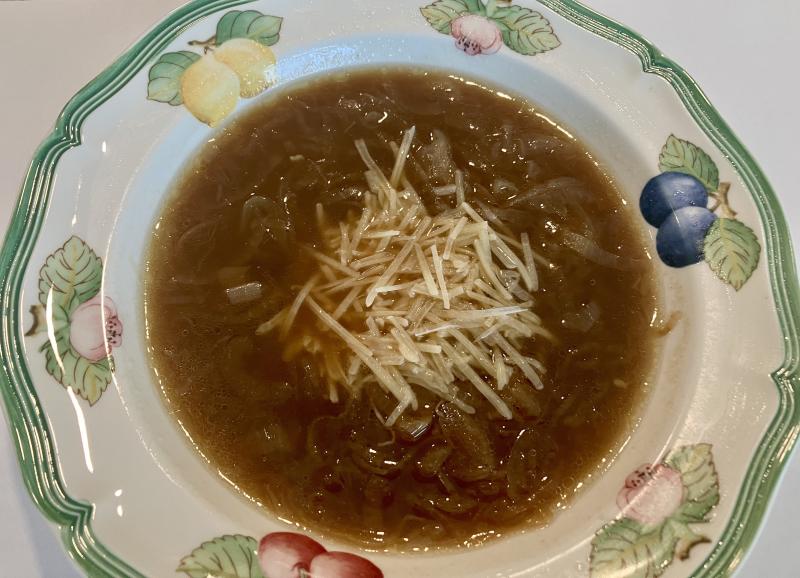Versatile onions can go from soup to salad and more
My friend Laurie went shopping for onions last week and purchased a three-pound bag because it was less expensive than buying the two individual onions she needed for her recipe. Since she didn’t want to keep the rest of the bag, I was the lucky recipient of the remainder. And, what better destination for all those onions than a pot of onion soup?
Onions belong to the allium family that also includes garlic, scallions, leeks and shallots. According to the National Onion Association, this ubiquitous vegetable is believed to have originated in the central Asian continent, where the wild ancestors of our modern onions were widely consumed. The earliest location of onion cultivation has been attributed to Iran and West Pakistan.
We have enjoyed this versatile ingredient in our diet for more than 5,000 years. Early written records from India and Sumer report its importance in art, medicine and mummification. Because of their transportability, ease of cultivation in a variety of climates, and adaptability to preservation, onions have long maintained a prominent place in our culinary repertoire.
When you cut open an onion, you will notice it is formed in concentric circles of flesh, which symbolized eternal life to early Egyptians. They entombed their pharaohs with onions in their eye sockets, and depicted onions in tomb paintings of religious altars and banquet tables. Greek athletes who participated in the earliest Olympic games consumed pounds of onions, drank onion juice and rubbed onions on their joints.
Strains of wild onions in this country were gathered by Native Americans and used in poultices, syrups and dyes. In addition, early European settlers brought onions to grow as a crop in their kitchen gardens. Today there are three basic types of onions found at market: yellow, white and red. The latter of these is the least pungent, and is often served raw in salads and sandwiches.
White onions do not store as well or as long as the other two and are most often seen in sauces, salads and Southwestern cuisine. Yellow onions come in two varieties, sweet (sometimes marketed as Vidalia onions) and sharp. These are the best for caramelizing, which brings out their nutty, mellow flavor notes, making them the onion of choice for onion soup.
The first step in preparing the onions is to thinly slice them. Since you will need to peel and slice so many to have enough for your pot of soup, it’s easier to use a mandoline than a knife. The best advice about using this diabolically sharp device is to protect your hand with a stainless steel mesh kitchen glove like the ones you may have seen used by oyster shuckers.
The next step is to melt butter and oil in a Dutch oven over very low heat and add the sliced onions. Caramelizing them will take close to an hour, with constant stirring to allow them to cook evenly. Unlike most recipes for onion soup, it isn’t necessary to add sugar to the pot when cooking the onions; all you really need is patience to bring them to a lovely golden-brown color.
Because the onions add so much flavor, there isn’t a need for much additional seasoning, just a splash of white wine and some salt. For traditional French onion soup, the liquid should be beef broth, not chicken or vegetable, and the final ingredient is some cognac. To serve, there are those who enjoy a slice of crusty bread topped with cheese, while others simply add the cheese, as in the photo. In either case, it is well worth the time and energy to cook all those onions!
French Onion Soup
5 C sliced yellow onions
3 T butter
1 T olive oil
1/3 C dry white wine
2 T sifted flour
2 qts beef broth
1/2 C cognac
salt and pepper, to taste
toasted sliced of French bread (optional)
1/2 C grated Romano cheese
Melt butter and oil in a Dutch oven over low heat. Add onions and cook, stirring often, until they are a deep golden brown, about 45 minutes. Add wine and stir to combine. Sift flour over the onions and cook until dissolved. Pour in broth, increase heat to medium-high and bring to a boil. Reduce heat to low, cover and simmer 20 minutes. When ready to serve, stir in cognac and cook 2 minutes longer. Season to taste with salt and pepper. To serve, ladle soup into bowl; add a toast round (if desired) and sprinkle with cheese. Yield: 6 servings.
Onion Jam Tarts*
1 sheet frozen puff pastry, thawed
2 T butter
1 sliced red onion
2 t honey
3 sprigs fresh thyme
Pinch salt & pepper
1/2 C cherry jam
3 oz crumbled goat cheese
Thyme leaves for garnish
Warmed honey for serving
Preheat the oven to 350 F. Unfold the sheet of puff pastry onto a cutting board; cut into 6 rectangles. Transfer to a parchment-lined baking sheet; set aside. Melt butter in a skillet over medium heat. Add onion and cook, stirring often, until it softens, about 5 minutes. Stir in the honey and sprigs of thyme. Add pinch of salt and pepper; remove from heat. Spread an equal amount of jam over each square of pastry. Top evenly with crumbled goat cheese. Remove the sprigs of thyme from the onions and divide the cooked onions over each of the tarts. Bake until the tarts are browned and cooked through, about 25 minutes. Serve warm, drizzled with warmed honey and sprinkled with fresh thyme leaves. Yield: 6 servings. *Adapted from the National Onion Association.



















































